Histone modification alteration coordinated with acquisition of promoter DNA methylation during Epstein-Barr virus infection
- PMID: 28903418
- PMCID: PMC5589657
- DOI: 10.18632/oncotarget.19423
Histone modification alteration coordinated with acquisition of promoter DNA methylation during Epstein-Barr virus infection
Abstract
Aberrant DNA hypermethylation is a major epigenetic mechanism to inactivate tumor suppressor genes in cancer. Epstein-Barr virus positive gastric cancer is the most frequently hypermethylated tumor among human malignancies. Herein, we performed comprehensive analysis of epigenomic alteration during EBV infection, by Infinium HumanMethylation 450K BeadChip for DNA methylation and ChIP-sequencing for histone modification alteration during EBV infection into gastric cancer cell line MKN7. Among 7,775 genes with increased DNA methylation in promoter regions, roughly half were "DNA methylation-sensitive" genes, which acquired DNA methylation in the whole promoter regions and thus were repressed. These included anti-oncogenic genes, e.g. CDKN2A. The other half were "DNA methylation-resistant" genes, where DNA methylation is acquired in the surrounding of promoter regions, but unmethylated status is protected in the vicinity of transcription start site. These genes thereby retained gene expression, and included DNA repair genes. Histone modification was altered dynamically and coordinately with DNA methylation alteration. DNA methylation-sensitive genes significantly correlated with loss of H3K27me3 pre-marks or decrease of active histone marks, H3K4me3 and H3K27ac. Apoptosis-related genes were significantly enriched in these epigenetically repressed genes. Gain of active histone marks significantly correlated with DNA methylation-resistant genes. Genes related to mitotic cell cycle and DNA repair were significantly enriched in these epigenetically activated genes. Our data show that orchestrated epigenetic alterations are important in gene regulation during EBV infection, and histone modification status in promoter regions significantly associated with acquisition of de novo DNA methylation or protection of unmethylated status at transcription start site.
Keywords: DNA methylation; Epstein-Barr virus; gastric cancer.
Conflict of interest statement
CONFLICTS OF INTEREST All authors have no potential conflicts of interest to disclose.
Figures
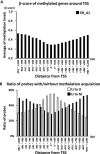
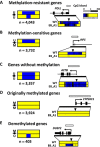
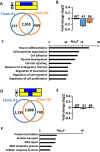
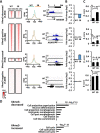
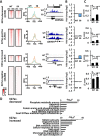
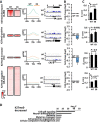

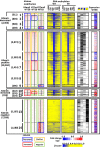
Similar articles
-
Genome-wide identification of Epstein-Barr virus-driven promoter methylation profiles of human genes in gastric cancer cells.Cancer. 2013 Jan 15;119(2):304-12. doi: 10.1002/cncr.27724. Epub 2012 Jul 25. Cancer. 2013. PMID: 22833454
-
Classification of Epstein-Barr virus-positive gastric cancers by definition of DNA methylation epigenotypes.Cancer Res. 2011 Dec 1;71(23):7187-97. doi: 10.1158/0008-5472.CAN-11-1349. Epub 2011 Oct 11. Cancer Res. 2011. PMID: 21990320
-
The 5' regulatory sequences of active miR-146a promoters are hypomethylated and associated with euchromatic histone modification marks in B lymphoid cells.Biochem Biophys Res Commun. 2013 Apr 19;433(4):489-95. doi: 10.1016/j.bbrc.2013.03.022. Epub 2013 Mar 23. Biochem Biophys Res Commun. 2013. PMID: 23528241
-
Gene methylation in gastric cancer.Clin Chim Acta. 2013 Sep 23;424:53-65. doi: 10.1016/j.cca.2013.05.002. Epub 2013 May 10. Clin Chim Acta. 2013. PMID: 23669186 Review.
-
Epigenetic Alterations in Epstein-Barr Virus-Associated Diseases.Adv Exp Med Biol. 2016;879:39-69. doi: 10.1007/978-3-319-24738-0_3. Adv Exp Med Biol. 2016. PMID: 26659263 Review.
Cited by
-
H3K27me3 induces multidrug resistance in small cell lung cancer by affecting HOXA1 DNA methylation via regulation of the lncRNA HOTAIR.Ann Transl Med. 2018 Nov;6(22):440. doi: 10.21037/atm.2018.10.21. Ann Transl Med. 2018. PMID: 30596070 Free PMC article.
-
The Impact of Epstein-Barr Virus Infection on Epigenetic Regulation of Host Cell Gene Expression in Epithelial and Lymphocytic Malignancies.Front Oncol. 2021 Feb 25;11:629780. doi: 10.3389/fonc.2021.629780. eCollection 2021. Front Oncol. 2021. PMID: 33718209 Free PMC article. Review.
-
Epigenetic reprogramming in gastrointestinal cancer: biology and translational perspectives.MedComm (2020). 2024 Aug 24;5(9):e670. doi: 10.1002/mco2.670. eCollection 2024 Sep. MedComm (2020). 2024. PMID: 39184862 Free PMC article. Review.
-
Thirty years of Epstein-Barr virus-associated gastric carcinoma.Virchows Arch. 2020 Mar;476(3):353-365. doi: 10.1007/s00428-019-02724-4. Epub 2019 Dec 13. Virchows Arch. 2020. PMID: 31836926 Review.
-
Cross-species chromatin interactions drive transcriptional rewiring in Epstein-Barr virus-positive gastric adenocarcinoma.Nat Genet. 2020 Sep;52(9):919-930. doi: 10.1038/s41588-020-0665-7. Epub 2020 Jul 27. Nat Genet. 2020. PMID: 32719515
References
-
- Feinberg AP, Ohlsson R, Henikoff S. The epigenetic progenitor origin of human cancer. Nat Rev Genet. 2006;7:21–33. - PubMed
-
- Jones PA. Functions of DNA methylation: islands, start sites, gene bodies and beyond. Nat Rev Genet. 2012;13:484–492. - PubMed
-
- Funata S, Fukayama M, Kaneda A. De NovoMethylation in. Cancer. 2016;eLS:1–7. https://doi.org/10.1002/9780470015902.a0026465. - DOI
-
- Matsusaka K, Kaneda A, Nagae G, Ushiku T, Kikuchi Y, Hino R, Uozaki H, Seto Y, Takada K, Aburatani H, Fukayama M. Classification of Epstein-Barr virus-positive gastric cancers by definition of DNA methylation epigenotypes. Cancer Res. 2011;71:7187–7197. - PubMed
-
- Wang K, Yuen ST, Xu J, Lee SP, Yan HH, Shi ST, Siu HC, Deng S, Chu KM, Law S, Chan KH, Chan AS, Tsui WY, et al. Whole-genome sequencing and comprehensive molecular profiling identify new driver mutations in gastric cancer. Nat Genet. 2014;46:573–582. - PubMed
LinkOut - more resources
Full Text Sources
Other Literature Sources
Molecular Biology Databases
Research Materials
Miscellaneous

